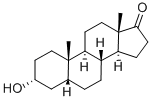53-42-9
中文名稱
3a-羥基-5b-雄甾烷-17-酮
英文名稱
Etiocholanone
CAS
53-42-9
分子式
C19H30O
MDL 編號(hào)
MFCD00064133
分子量
274.44
MOL 文件
53-42-9.mol
更新日期
2024/07/02 17:36:11
 53-42-9 結(jié)構(gòu)式
53-42-9 結(jié)構(gòu)式
基本信息
中文別名
還原膽烷醇酮還原尿睪酮
苯膽烷醇酮
3a-羥基-5b-雄甾烷-17-酮
英文別名
3ALPHA-ETIOCHOLANOLONE3ALPHA-HYDROXY-5BETA-ANDROSTAN-17-ONE
5BETA-ANDROSTAN-3ALPHA-OL-17-ONE
5BETA-ANDROSTAN-3A-OL-17-ONE
5BETA-ANDROSTERONE
ETIOCHOLAN-3ALPHA-OL-17-ONE
ETIOCHOLAN-3A-OL-17-ONE
ETIOCHOLANOLON
ETIOCHOLANOLONE
ETIOCHOLANONE
5beta-Androstan-17-one, 3alpha-hydroxy-
5-Isoandrosterone
Androstan-17-one, 3-hydroxy-, (3alpha,5beta)-
Androstan-3alpha-ol-17-one
Androsterone, (5beta)-
etiocholan-3A-ol-17-one crystalline
ETIOCHOLANOLONE (5B-ANDROSTAN-3A-OL-17-O NE)
5BETA-ANDROSTAN-3ALPHA-OL-17-ON 98%
ETIOCHOLANOLONE VETRANAL, 100 MG
etiocholan-3α-ol-17-one
物理化學(xué)性質(zhì)
熔點(diǎn)148~150℃
沸點(diǎn)392.52°C (rough estimate)
密度0.9731 (rough estimate)
折射率1.5360 (estimate)
閃點(diǎn)2℃
儲(chǔ)存條件room temp
溶解度DMSO: 100 mg/mL (344.31 mM)
酸度系數(shù)(pKa)15.14±0.60(Predicted)
形態(tài)固體
顏色White to off-white
水溶解性20.33mg/L(25 ºC)
BRN2217625
CAS 數(shù)據(jù)庫(kù)53-42-9(CAS DataBase Reference)
NIST化學(xué)物質(zhì)信息Androstan-17-one, 3-hydroxy-, (3«alpha»,5«beta»)-(53-42-9)
安全數(shù)據(jù)
警示詞警告
危險(xiǎn)性描述H302-H351-H361fd-H410
防范說(shuō)明P202-P264-P270-P273-P301+P312-P308+P313
危險(xiǎn)品標(biāo)志F,Xn
危險(xiǎn)類別碼11-20/21/22-36
安全說(shuō)明16-36/37
危險(xiǎn)品運(yùn)輸編號(hào)UN 1648 3 / PGII
WGK Germany3
常見問題列表
生物活性
Etiocholanolone (5β-Androsterone) 是睪酮的排泄代謝物,具有抗驚厥活性。相對(duì)于其對(duì)映體形式,Etiocholanolone 是一種較弱的神經(jīng)甾醇類?GABAA?receptor 正向變構(gòu)調(diào)節(jié)劑。體外研究
Etiocholanolone (10 μM) coapplication with GABA leads to an increase in the relative frequency of long openings (fraction of OT3, site A2 effect), but it is ineffective at increasing the duration of long openings (site B effect) or at decreasing the relative frequency of the activation-related closed time component (site A1 effect).
體內(nèi)研究
Etiocholanolone (intraperitoneal injection; 0-109.1 mg/kg; single dose) exhibits ED50?values of 57.6 and 109.1 mg/kg in the 6-Hz and PTZ tests, respectively. Protective activity in the 6-Hz test of 5β,3α-A persists for 2 h and is shorter than ent-5β,3α-A treatment (3 hours) in mice.



